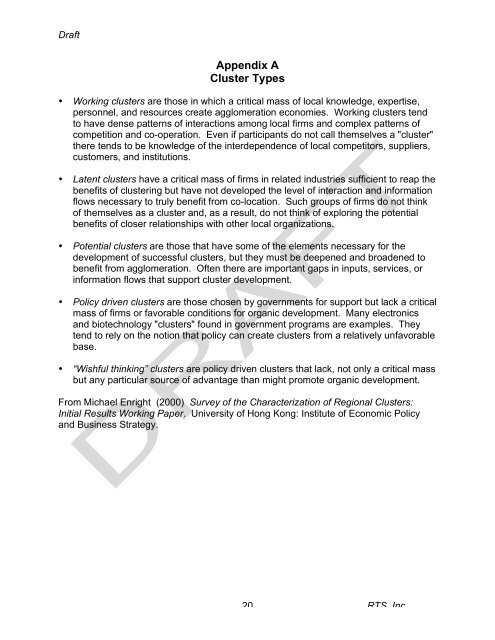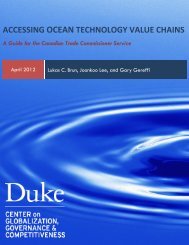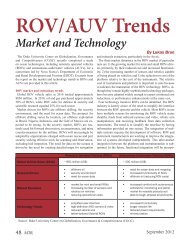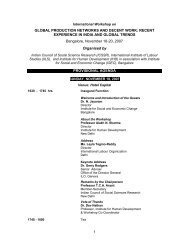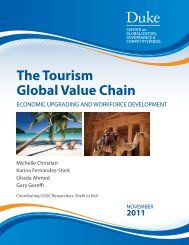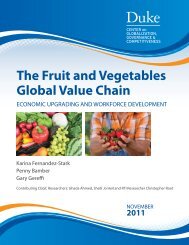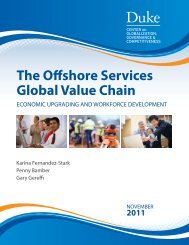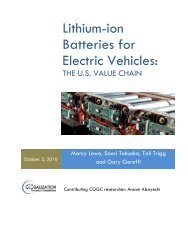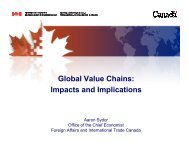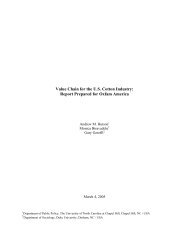Paper - Center on Globalization, Governance & Competitiveness
Paper - Center on Globalization, Governance & Competitiveness
Paper - Center on Globalization, Governance & Competitiveness
You also want an ePaper? Increase the reach of your titles
YUMPU automatically turns print PDFs into web optimized ePapers that Google loves.
Draft<br />
Appendix A<br />
Cluster Types<br />
• Working clusters are those in which a critical mass of local knowledge, expertise,<br />
pers<strong>on</strong>nel, and resources create agglomerati<strong>on</strong> ec<strong>on</strong>omies. Working clusters tend<br />
to have dense patterns of interacti<strong>on</strong>s am<strong>on</strong>g local firms and complex patterns of<br />
competiti<strong>on</strong> and co-operati<strong>on</strong>. Even if participants do not call themselves a "cluster"<br />
there tends to be knowledge of the interdependence of local competitors, suppliers,<br />
customers, and instituti<strong>on</strong>s.<br />
• Latent clusters have a critical mass of firms in related industries sufficient to reap the<br />
benefits of clustering but have not developed the level of interacti<strong>on</strong> and informati<strong>on</strong><br />
flows necessary to truly benefit from co-locati<strong>on</strong>. Such groups of firms do not think<br />
of themselves as a cluster and, as a result, do not think of exploring the potential<br />
benefits of closer relati<strong>on</strong>ships with other local organizati<strong>on</strong>s.<br />
• Potential clusters are those that have some of the elements necessary for the<br />
development of successful clusters, but they must be deepened and broadened to<br />
benefit from agglomerati<strong>on</strong>. Often there are important gaps in inputs, services, or<br />
informati<strong>on</strong> flows that support cluster development.<br />
• Policy driven clusters are those chosen by governments for support but lack a critical<br />
mass of firms or favorable c<strong>on</strong>diti<strong>on</strong>s for organic development. Many electr<strong>on</strong>ics<br />
and biotechnology "clusters" found in government programs are examples. They<br />
tend to rely <strong>on</strong> the noti<strong>on</strong> that policy can create clusters from a relatively unfavorable<br />
base.<br />
• “Wishful thinking” clusters are policy driven clusters that lack, not <strong>on</strong>ly a critical mass<br />
but any particular source of advantage than might promote organic development.<br />
From Michael Enright (2000) Survey of the Characterizati<strong>on</strong> of Regi<strong>on</strong>al Clusters:<br />
Initial Results Working <str<strong>on</strong>g>Paper</str<strong>on</strong>g>. University of H<strong>on</strong>g K<strong>on</strong>g: Institute of Ec<strong>on</strong>omic Policy<br />
and Business Strategy.<br />
20<br />
RTS, Inc.


